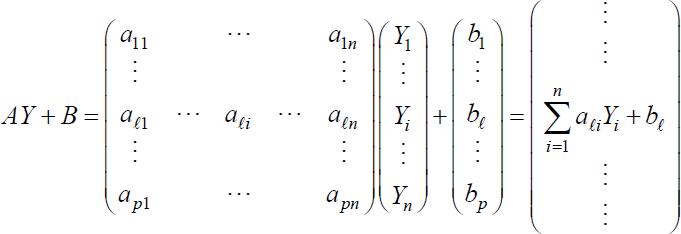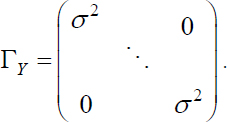2.4. Affine transformation of a Gaussian vector
We can generalize to vectors the following result on Gaussian r.v.:
If Y ∼ N (m, σ2) then ∀a, b ∈ ![]() aY + b ∼ N (am + b, a2 σ2).
aY + b ∼ N (am + b, a2 σ2).
By modifying a little the annotation, with N (am + b, a2 σ2) becoming N (am + b, a VarYa), we can imagine already how this result is going to extend to Gaussian vectors.
PROPOSITION.– Given a Gaussian vector Y ∼ Nn (m, ΓY), A a matrix belonging to M (p, n) and a certain vector B ∈ ![]() p, then AY + B is a Gaussian vector ∼ Np (Am + B, AΓY AT).
p, then AY + B is a Gaussian vector ∼ Np (Am + B, AΓY AT).
DEMONSTRATION.–

– this is indeed a Gaussian vector (of dimension p) because every linear combination of its components is an affine combination of the r.v. Y1,…, Yi,…, Yn and by hypothesis YT = (Y1,…, Yn) is a Gaussian vector;
– furthermore, we have seen that if Y is a 2nd order vector:
E(AY + B) = AEY + B = Am + B and ΓAY+B = AΓYAT.
EXAMPLE.– Given (n + 1) independent r.v. Yj ∼ N (μ, σ2) j = 0 at n, it emerges YT = (Y0, Y1,…, Yn) ∼ Nn+1 (m, ΓY) with mT = (μ,…, μ) and 
Furthermore, given new r.v. X defined by:
X1 = Y0 + Y1,…, Xn = Yn−1 + Yn,
the vector XT = (Xl,…, Xn) is Gaussian ...
Get Discrete Stochastic Processes and Optimal Filtering now with the O’Reilly learning platform.
O’Reilly members experience books, live events, courses curated by job role, and more from O’Reilly and nearly 200 top publishers.

